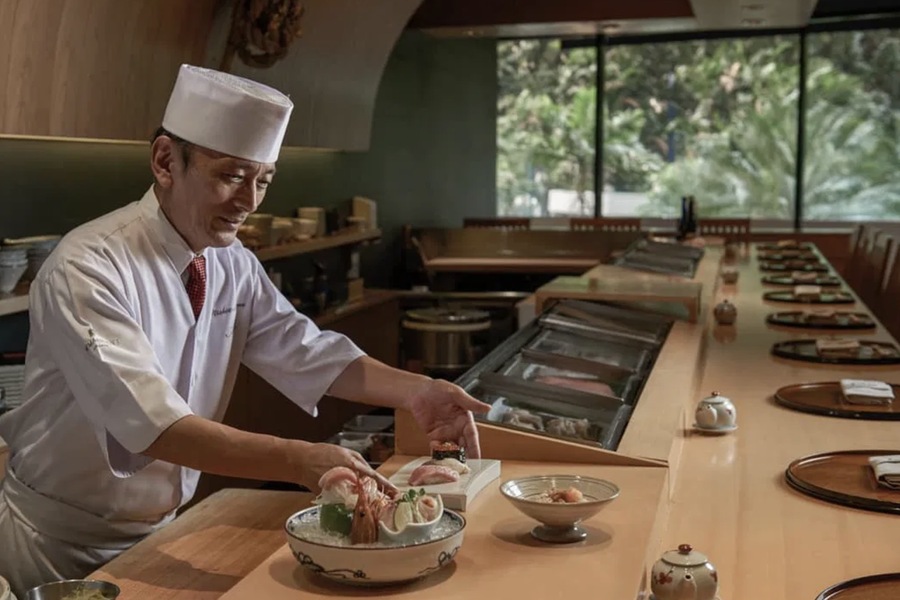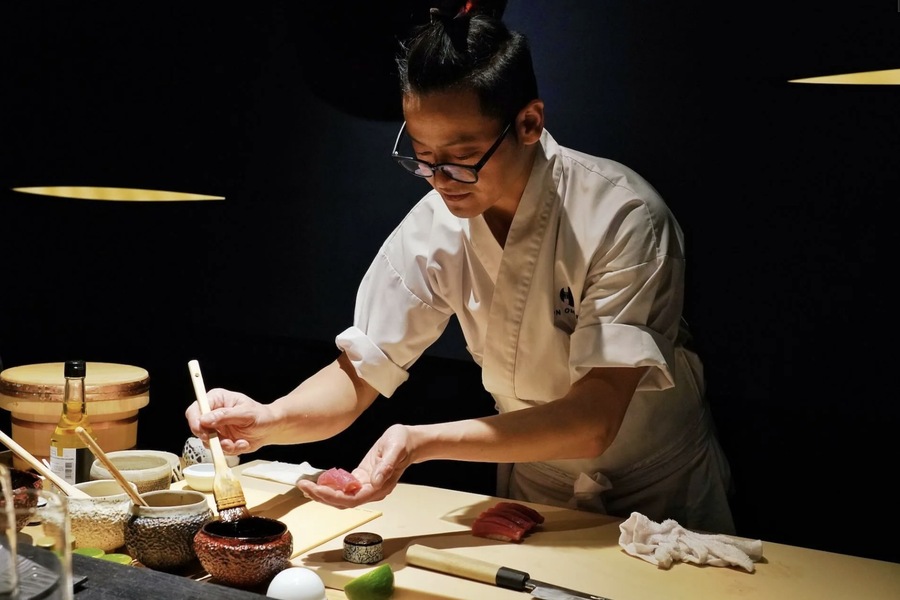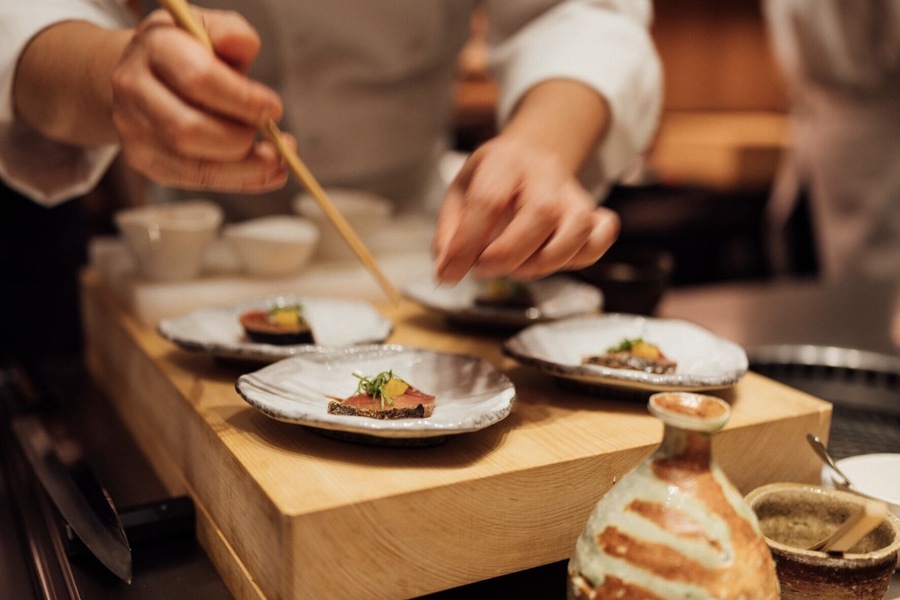Omakase is a revered Japanese dining tradition where the guest entrusts the chef entirely to select and prepare the meal. Translated from Japanese, “omakase” means “I trust you” or “I leave it to you,” reflecting the unique philosophy behind this culinary experience. Often found in high-end establishments that are considered the best bar in the city, omakase dining is rooted in deep trust and is more than just a meal—it is a journey through flavors, creativity, and the freshest seasonal ingredients, curated with the expertise of a highly skilled chef.
The Philosophy of Omakase
The essence of omakase lies in the relationship between the diner and the chef. This relationship is based on a few fundamental principles that elevate omakase to a celebrated dining tradition:
- Complete Trust in the Chef
The core of omakase is the diner’s trust in the chef’s judgment. The guest has no knowledge of the dishes that will be served. Instead, the chef, using his years of training, knowledge, and intuition, crafts a personalized menu based on the freshest ingredients and his culinary vision. This transforms each meal into a unique and exciting event, with every dish served as a surprise. - Emphasis on Freshness and Seasonality
The menu at an omakase restaurant changes frequently—sometimes daily—based on what is available in the market that day. This ensures the highest quality ingredients, showcasing the best seasonal products. Whether it’s the first catch of the season or peak-harvest vegetables, omakase reflects nature’s rhythms and celebrates the fleeting beauty of each season. - Personalized Culinary Experience
While the guest surrenders control to the chef, personal preferences and dietary restrictions are often considered. The chef uses this information to curate a meal that not only reflects his expertise but also aligns with the diner’s individual tastes, creating an intimate and tailored experience. - Interaction with the Chef
One of the most distinctive aspects of omakase dining is the close proximity to the chef. In traditional omakase settings, diners are seated at the counter, directly in front of the chef’s workspace. This setup allows the guest to watch the meticulous preparation of each dish, observe the chef’s techniques, and engage in conversation, offering a window into the artistry behind the food.
The Craftsmanship of Omakase
Omakase chefs are highly skilled and take great pride in their craft. Their expertise is evident not only in the preparation of the food but in the thoughtful presentation and precision that goes into every dish. Particular attention is paid to:
The Technique of Cutting Fish
One of the most critical skills in Japanese cuisine, especially in sushi preparation, is the ability to cut fish with precision. Each slice of fish, whether for sushi or sashimi, must be cut at the correct angle and thickness to enhance the flavor and texture.
Rice Preparation
Sushi rice (shari) is another element of perfection in omakase. The rice must be cooked, seasoned, and formed correctly to achieve the perfect balance of stickiness and flavor, providing a complementary base for raw fish.
Ingredient Ratios
The balance of ingredients is carefully considered, from the amount of wasabi added to sushi to the ratio of rice to fish. The goal is to create harmony in every bite, ensuring that no single element overpowers the others.

The Omakase Experience
When dining at an omakase restaurant, guests can expect a journey through flavors and techniques that unfold in a particular sequence. Each dish is carefully selected to enhance the overall experience, starting with lighter flavors and progressing to richer, more intense tastes.
- Appetizers
The meal often begins with light, palate-awakening dishes such as a delicate chawanmushi (steamed egg custard) with crab or sashimi with fresh seaweed. These initial courses set the tone for the rest of the meal. - Fresh Seafood
Omakase is synonymous with the freshest seafood available. The chef may offer a selection of oysters, bluefin tuna, or sea urchin, carefully prepared to highlight their natural flavors. - Soup
A warm soup, like vongole soup (made from clams) or a traditional dashi broth, is often served to cleanse the palate between courses and prepare the diner for the next stage of the meal. - Sushi
The centerpiece of most omakase meals is sushi. The chef serves a variety of sushi, starting with lighter fish like sea bream or flounder and moving to richer, fattier fish such as toro (fatty tuna). Each piece of sushi is handcrafted to perfection and often eaten in one bite to fully appreciate its texture and flavor. - Hot Dishes
Some omakase experiences include a hot dish, such as grilled wagyu beef or braised beef cheeks. These dishes showcase the chef’s versatility and ability to handle various cooking techniques. - Dessert
The meal typically concludes with a seasonal dessert, which might be a delicate fruit sorbet or a light ice cream, chosen to complement the flavors of the previous dishes.
The Art and Aesthetics of Omakase
Each dish in omakase is not just food—it is art. From the vibrant colors of the ingredients to the precision in plating, aesthetics play a vital role. Chefs often use natural elements such as leaves, flowers, and ceramic dishes to enhance the presentation. The use of traditional Japanese ceramics further elevates the visual appeal, creating a feast for the eyes as well as the palate.
Guests in an omakase restaurant can often see this artistry in action as they watch the chef meticulously prepare each dish. Whether it’s the graceful slicing of fish or the precise molding of sushi rice, every movement is a testament to the chef’s years of dedication to their craft.

Interesting Facts about Omakase
Not limited to sushi
While many people associate omakase with sushi, the experience can also include a wide range of dishes, from grilled and fried items to soups and desserts.
Progression of flavors
The order in which dishes are served is intentional. Lighter, more delicate fish is often served first, followed by richer, fattier fish as the meal progresses.
Etiquette
When dining at an omakase restaurant, it’s important to observe certain customs. Dressy casual or semi-formal attire is typically recommended. Strong perfumes should be avoided, as they can interfere with the subtle aromas of the dishes. It’s also customary to greet the chef with “itadakimasu” (I gratefully receive) before the meal and thank them with “gochisousama deshita” (thank you for the meal) afterward.
Conclusion
Omakase is a celebration of trust, craftsmanship, and the joy of discovering new flavors. By allowing the chef to take the reins, diners embark on a culinary adventure that is tailored to the freshest ingredients and the chef’s creative vision. Whether it’s the precise cut of a piece of sashimi or the simple pleasure of perfectly seasoned sushi rice, omakase dining is a true art form that showcases the best of Japanese cuisine. Each meal becomes a story told through food, leaving diners with an unforgettable experience that goes beyond the act of eating—it becomes a cherished memory.

Hiking addict, vegan, fender owner, Eames fan and brand builder. Working at the nexus of simplicity and intellectual purity to answer design problems with honest solutions. Concept is the foundation of everything else.
